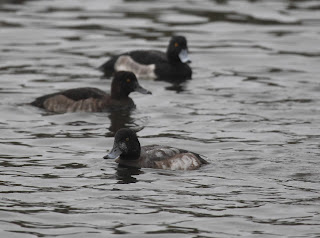Last week I spent a very enjoyable week in the Dumfries and Galloway area, with endless green fields and rolling hills it really is idyllic, and has some great birding to offer as well. Our first stop was RSPB Ken-Dee Marshes and the Red Kite feeding station. While the latter doesn't provide the excitement of finding one of these stunning birds for yourself, it does provide a magnificent spectacle and the chance to see massive numbers of these often shy and distant predators. Some of the birds present were also wing-tagged as part of a national scheme to study their movements. In this first photo, the top bird has a purple tag on its right wing meaning it hatched in 2007 and a green tag on its left wing, meaning it was hatched in the Dumfries and Galloway area. At Ken-Dee, there was a lovely flock of Greenland White-fronted Geese, some of which had neck collars on that we were able to read and report back to the scheme.
 |
| Red Kite, Milvus milvus |
 |
| Red Kite feeding frenzy |
 |
| Greenland White-fronted Geese, Anser albifrons flavirostris |
We also spent some time on the coast around Southerness, which has some beautiful scenery as well as some good birds on offer. Redshank, Oystercatcher and Turnstone were numerous and confiding, as was a single Snipe and three Red-breasted Mergansers. The highlight for me were four Purple Sandpipers that showed very well on a little rocky island, being very reluctant to leave and getting battered by waves.
The next few days involved a trip to WWT Caerlaverock and a bit of a twitch. At Caerlaverock we were treated to thousands and thousands of Barnacle Geese, a lovely flock of close in Whooper Swans, a drake Green-winged Teal and this moulting Greater Scaup, as well as plenty of other wildfowl, Fieldfare and Goldcrest.
 |
| Whooper Swan, Cygnus cygnus |
 |
| Greater Scaup, Aythya marila |
The twitch involved somewhat less attractive surroundings, the hotel car park (although the hotel was rather fancy) on the edge of Loch o' Th' Lowes in Ayrshire, where a Ring-necked Duck has taken up residence and had also been joined by a Long-tailed Duck. Looking out over the Loch it was a rather beautiful setting, we just had to forget what was behind us! This American vagrant is becoming more and more frequent in UK waters, although the origin of each bird is questioned as they can often escape from captivity. These ducks are also unusual in that they pair up during their spring migration. I love waterfowl, and this little stunner was well worth the short trip we made for it.
 |
| Ring-necked Duck, Aythya collaris |
On our way back to Norfolk on Sunday we heard of the Pied Wheatear that had arrived at Collingham gravel pits in Notts. As this site is within a stones throw of the A1, we couldn't resist. The bird was showing well in poor light by the time we go there. It was a first winter/female type bird and as such wasn't the most exciting to look at, still a lovely little Eastern vagrant to finish off a lovely week away. There was also an adult Yellow-legged Gull present in the roost at the back of the pits.
 |
| Pied Wheatear, Oenantha pleschanka |